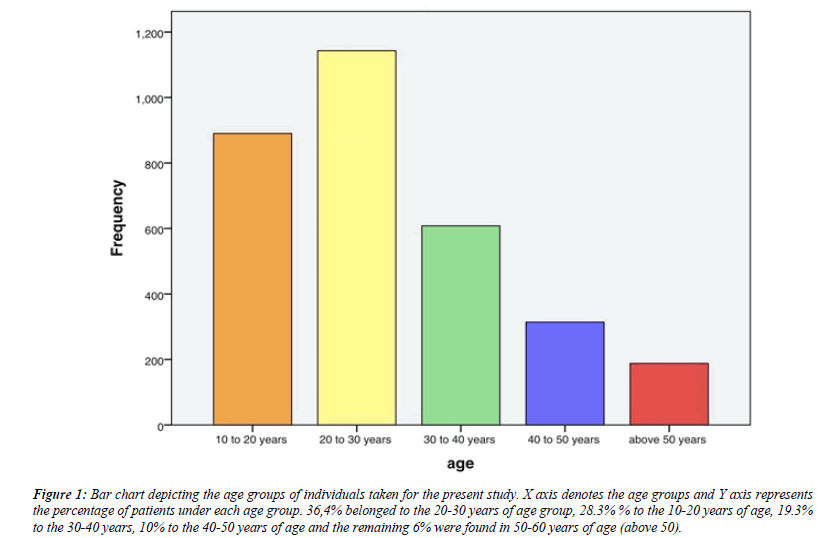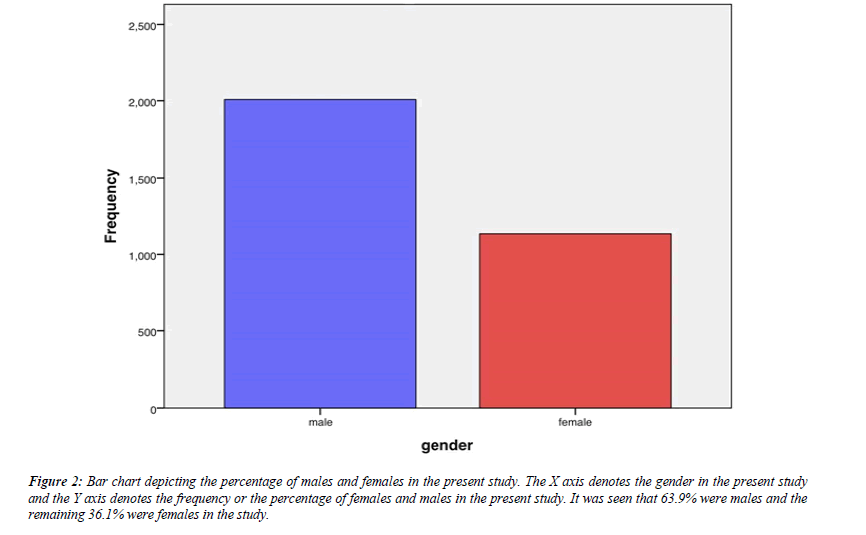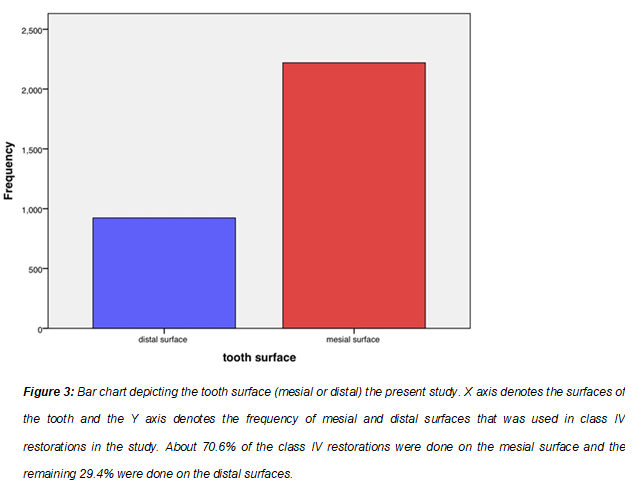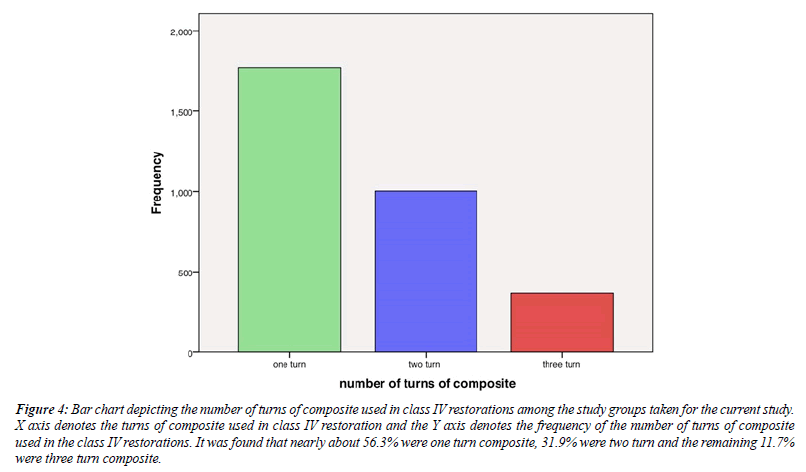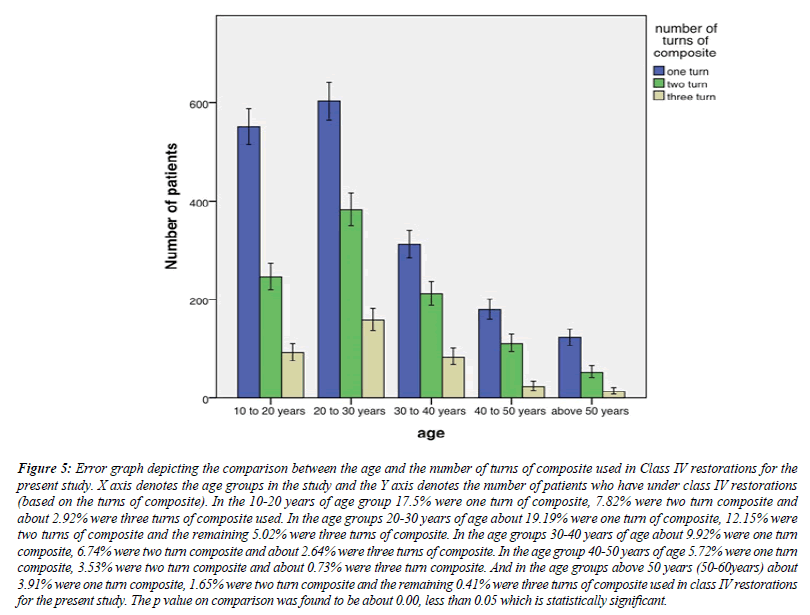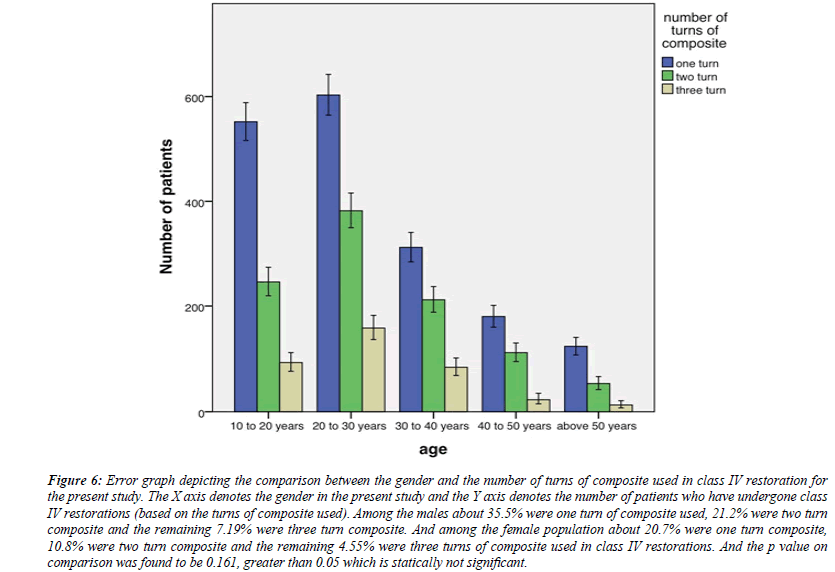Research Article - Journal of Clinical Dentistry and Oral Health (2023) Volume 7, Issue 2
Association of age and gender with turns of composite in class IV restorations
Rithanya P1*, Surendar Sugumaran2, Senthil Murugan Pandurangan3
1Saveetha dental college and hospitals, Saveetha institute of medical and technical sciences, Chennai
2Department of conservative dentistry and endodontics, Saveetha dental college, Saveetha institute of medical and technical sciences, Chennai
3Department of oral surgery, Saveetha dental college and hospitals, Saveetha institute of medical and technical sciences, Saveetha university, Chennai
- Corresponding Author:
- Rithanya P
Saveetha Dental College and Hospitals
Saveetha Institute of Medical and Technical Sciences
Chennai
E-mail: 151701072.sdc@saveetha.com
Received: 01-Mar-2023, Manuscript No. AACDOH-23-88194; Editor assigned: 04-Mar-2023, PreQC No. AACDOH-23-88194 (PQ); Reviewed: 18-Mar-2023, QC No. AACDOH-23-88194; Revised: 22-Mar-2023, Manuscript No. AACDOH-23-88194(R); Published: 29-Mar-2023, DOI:10.35841/aacdoh-7.2.140
Citation: Rithanya P. Association of age and gender with turns of composite in class IV restorations. J Clin Dentistry Oral Health.2023;7(2):140
Keywords
Class IV dental caries, Ellis class I and II fractures, Composite resin, One turn, Two turn, Three turn, Esthetic concerns, Innovative technique.
Introduction
Dental caries and trauma including tooth fractures, avulsion as well as non carious lesions are the common reasons thereby leading to pulpal inflammation [1]. Dental caries is defined as an infectious microbiological disease of the teeth that results in localised dissolution and destruction of the calcified tissues of the teeth [2]. Simon added a new class to the GV Blacks classification of dental caries. According to Simon's classification, Class VI lesions were described as those occurring at the incisal edge or occlusal cusps due to attrition, abrasion or erosion [3]. Class VI lesion was also referred to as “Simon’s modification” [4].
Class VI enamel defects of enamel are usually seen in the older, worn out teeth in which the enamel layer has been lost resulting in exposure of low mineralized dentin (Figure 1). Class VI caries of the posterior teeth usually tend to occur on the cusp tips which are usually sites due to the absence of obvious patencies like pits and fissures that serve as areas for biofilm formation and plaque accumulation. Therefore the exact etiology of class IV caries remains unknown [5]. Few authors believe that microscopic porosities develop at the cusp tips or the incisal edges naturally or mostly due to the masticatory stresses, which thereby promotes microbial colonization and caries progression (Figure 2 & 3). As the caries lesion develops, the area gets further demineralised and results in breakdown of the tooth structure [2]. So far, various materials like gold foil, silver amalgam, resin based composites and ceramics have been used to restore Class IV defects [6-16].
Figure 1: Bar chart depicting the age groups of individuals taken for the present study. X axis denotes the age groups and Y axis represents the percentage of patients under each age group. 36,4% belonged to the 20-30 years of age group, 28.3% % to the 10-20 years of age, 19.3% to the 30-40 years, 10% to the 40-50 years of age and the remaining 6% were found in 50-60 years of age (above 50).
Figure 2:Bar chart depicting the percentage of males and females in the present study. The X axis denotes the gender in the present study and the Y axis denotes the frequency or the percentage of females and males in the present study. It was seen that 63.9% were males and the remaining 36.1% were females in the study.
Figure 3:Bar chart depicting the percentage of males and females in the present study. The X axis denotes the gender in the present study and the Y axis denotes the frequency or the percentage of females and males in the present study. It was seen that 63.9% were males and the remaining 36.1% were females in the study.
Materials and method
Study design: Institutional based Retrospective study
Study setting: Private dental institution in Chennai
Study size: 21,000 patients who have undergone treatment for ellis class I or class II fractures from June 2020 to July 2021.
Sampling and Scheduling: Owing to the nature of the study design and setting, a convenience sampling method was used, and the data was collected from April 2020 to February 2021.
Survey instrument: Data collection was done using patient management software which has all the patient’s records.
Inclusion and Exclusion criteria: Inclusion criteria includes patients undergoing treatment for Ellis class I or Ellis class II fractures. Exclusion criteria include age, gender, systemic diseases, occupation, etc.
Ethical clearance: Prior to the start of the study, ethical clearance was obtained from the institution ethical committee of Saveetha University.
Statistical analysis: The data from the patient management software was transferred into excel and was then imported to SPSS software by IBM, version 25. Descriptive statistics were done using frequency and percentage. Inferential statistics were done using the Chi- square test. Interpretation was based on the p value less than 0.05 which is statistically significant [17-26].
Results
From the results of the present study it was seen that, higher percentage of one turn composite was being used, nearly about 56.3% when compared to the two turn and three turns of composite. In comparison with age and turns of composite in the present study, p value was found to be 0.00, less than 0.05 which is statistically significant. In comparison with gender and the turns of composite used in class IV restoration p value was found to be 0.161 which is statistically not significant.
Discussion
The parameters assessed in this study were age, gender and turns of composite used for Class IV restorations. The retrieved data had 3500 cases of Class IV composite restoration in one turn, two turns and three turns. Association was done between age, gender and type of restoration using chi square test which showed statistical significant difference between age and Class IV composite restorations.[p value<0.05 (chi square test)] .
In this study association of age and gender with Class IV composite restorations was evaluated by associating age and gender of the study groups with the type of restoration used for Class IV cases. When the frequency of placement of Class IV restorations was studied, it showed that most of the cases belonged to the age group of 20 to 30 years and below and most of them involved the teeth of sextant 2 and sextant 1 where a conservative design of carious removal was followed prior to composite restoration. When association was done between age and turns of turns of composite in class IV restorations a statistical significant difference was seen with most of the individuals aged 20-30 years and below. When association was done between the gender and turns of turns of composite in class IV restorations statistical significant difference was not seen with most of the individuals aged 20-30 years and below (Figure 4 & 5).
Figure 4:Bar chart depicting the number of turns of composite used in class IV restorations among the study groups taken for the current study. X axis denotes the turns of composite used in class IV restoration and the Y axis denotes the frequency of the number of turns of composite used in the class IV restorations. It was found that nearly about 56.3% were one turn composite, 31.9% were two turn and the remaining 11.7% were three turn composite.
Figure 5:Error graph depicting the comparison between the age and the number of turns of composite used in Class IV restorations for the present study. X axis denotes the age groups in the study and the Y axis denotes the number of patients who have under class IV restorations (based on the turns of composite). In the 10-20 years of age group 17.5% were one turn of composite, 7.82% were two turn composite and about 2.92% were three turns of composite used. In the age groups 20-30 years of age about 19.19% were one turn of composite, 12.15% were two turns of composite and the remaining 5.02% were three turns of composite. In the age groups 30-40 years of age about 9.92% were one turn composite, 6.74% were two turn composite and about 2.64% were three turns of composite. In the age group 40-50 years of age 5.72% were one turn composite, 3.53% were two turn composite and about 0.73% were three turn composite. And in the age groups above 50 years (50-60years) about 3.91% were one turn composite, 1.65% were two turn composite and the remaining 0.41% were three turns of composite used in class IV restorations for the present study. The p value on comparison was found to be about 0.00, less than 0.05 which is statistically significant.
Other studies proved a lesser count of class IV restoration done above the age group of 30 years because of the excessive attrition leading to fracture to cusp or development of Class IV lesion. The conservative approach was followed more among younger individuals as localized caries lesion was seen [27]. On correlating tooth number and turns of composite in class IV restorations, no significant difference was seen. Sextant 2 and sextant 1 was seen to be commonly involved with Class IV lesions and both caries removal and cusp build up was equally practiced prior to composite restoration. On associating age and turns of composite in class IV restoration, higher restorations were seen among the 20 to 30 years of age. And on comparison with the gender and the turns of composite used in class IV restorations higher percentage of one turn composite was used both among the male and female population.
Direct restoration technique was more commonly followed in younger and older age groups with bilayered restoration being practiced more among the middle age group. The association between age and tooth number showed no significant difference with both direct restoration and bilayered restorations being practiced almost equally among all teeth. The practice of direct restoration is more commonly seen in young age groups as they are aware and conscious about dental esthetics which makes them approach the dentist during early stages of caries which can be managed without pulp protection [28]. In older individuals, presence of increased sclerotic dentin, dead tracts, formation of reparative and reactive dentin would all protect the pulp from the progressing dental caries. This makes restorations possible without pulp protection in most of the older individuals [29] .With the developing dental awareness, tooth structure loss these days is caused more due to physiologic changes in the tooth than dental caries. Advancements in restorative dentistry have led to the use of additive techniques over subtractive approaches for restoring lost tooth structures (Figure 6).
Figure 6:Error graph depicting the comparison between the gender and the number of turns of composite used in class IV restoration for the present study. The X axis denotes the gender in the present study and the Y axis denotes the number of patients who have undergone class IV restorations (based on the turns of composite used). Among the males about 35.5% were one turn of composite used, 21.2% were two turn composite and the remaining 7.19% were three turn composite. And among the female population about 20.7% were one turn composite, 10.8% were two turn composite and the remaining 4.55% were three turns of composite used in class IV restorations. And the p value on comparison was found to be 0.161, greater than 0.05 which is statically not significant.
Occlusal loss of tooth structure resulting in wearing away or fracture of the cusps can also be considered as a Class IV lesion. Such cases, resulting in minimal loss of tooth structure can be restored using composite resins. Direct composite build ups for the restoration of moderate to large Class IV defects and for cusp buildup of posterior teeth have shown deterioration in shape, fit and surface texture of restorations [29]. With the position of the tooth being unfavorable in case of molars, direct restoration of moderate to large tooth structure loss has shown poor survival rates and in such cases, for re-establishment of tooth structure indirect restorations with on lays have been proposed. These indirect restorations along with minimal reduction of hard tissue, provides a stable and physiologic occlusion along with optimal form and esthetics [30]. Therefore, prior to restoring any Class IV defect, a thorough clinical examination and assessment of the defect is necessary which would further dictate the type of preparation and the restorative technique.
Conclusion
This study showed higher rates of one turn composite was used when compared to two and three turns use of composite in class IV restorations. And in comparison with the age and gender with the turns of composite used in class IV restorations, higher rates of one turn composite was used among both the male and female population and also among the 20-30 years of age and less than 20 years.
Acknowledgement
The authors would like to thank the university, Saveetha Institute of Medical and Technical Sciences, Saveetha Dental College and Hospitals for providing the required necessities for the present study.
Source of Funding
?The present project is supported by
? Saveetha Dental College and Hospitals
? Saveetha Institute of Medical and Technical Science
? Saveetha University
? Silver Valley Tea Industries.
Conflict of Interest
The authors declare that there were no conflicts of interest in the present study.
References
- Spinler K, Valdez R, Aarabi G, et, al. Development of the Oral Health Literacy Profile (OHLP)-Psychometric properties of the oral health and dental health system knowledge scales. Comm Dent and Oral Epidemiology. 2021;49(6):609-16.
- Sturdevant CM, Roberson TM. The art and science of operative dentistry. Mosby Elsevier Health Science.1995.
- Boushell LW, Heymann HO, Ritter AV, et al. Six-year clinical performance of etch-and-rinse and self-etch adhesives. Dent Mater. 2016;32(9):1065–72.
- Knight GM, McIntyre JM, Craig GG, et al. Leave decay in my cavity? You must be kidding! Dent Today. 2010;29(2):130, 132–3.
- Brown LR, White JO, Horton IM, et, al. Effect of continuous fluoride gel use on plaque fluoride retention and microbial activity. J Dent Res. 1983;62(6):746–51.
- Shah N. Dental caries: the disease and its clinical management. Br Dent J. 2009
- Muthukrishnan L. Imminent antimicrobial bioink deploying cellulose, alginate, EPS and synthetic polymers for 3D bioprinting of tissue constructs. Carbohydr Polym. 2021;15(260):117774.
- PradeepKumar AR, Shemesh H, Nivedhitha MS, et al. Diagnosis Of Vertical Root Fractures By Cone-Beam Computed Tomography In Root-Filled Teeth With Confirmation By Direct Visualization: A Systematic Review And Meta-Analysis. J Endod. 2021;47(8):1198–214.
- Chakraborty T, Jamal RF, Battineni G, et, al. A Review of Prolonged Post-COVID-19 Symptoms and Their Implications on Dental Management. Int J Env Res Pub Hea. 2021;1218-10.
- Muthukrishnan L. Nanotechnology for cleaner leather production: a review. Env Chem Lett. 2021 ;19(3):2527–49.
- Teja KV, Ramesh S. Is a filled lateral canal - A sign of superiority? J Dent Sci. 2020;15(4):562–3.
- Narendran K, Jayalakshmi, Ms N, Sarvanan A, et, al. Synthesis, characterization, free radical scavenging and cytotoxic activities of phenylvilangin, a substituted dimer of embelin. ijps. 2020;82(5).
- Reddy P, Krithikadatta J, Srinivasan V, et, al. Dental Caries Profile and Associated Risk Factors Among Adolescent School Children in an Urban South-Indian City. Oral Health Prev Dent. 2020 ;18(1):379–86.
- Sawant K, Pawar AM, Banga KS, et al. Dentinal Microcracks after Root Canal Instrumentation Using Instruments Manufactured with Different NiTi Alloys and the SAF System: A Systematic Review. Adv Sci Inst Ser E Appl Sci. 2021;11(11):4984.
- Bhavikatti SK, Karobari MI, Zainuddin SLA,et al. Investigating the Antioxidant and Cytocompatibility of Mimusops elengi Linn Extract over Human Gingival Fibroblast Cells. Int J Env Res Pub Health. 2021;18(13).
- Karobari MI, Basheer SN, Sayed FR, et al. An In Vitro Stereomicroscopic Evaluation of Bioactivity between Neo MTA Plus, Pro Root MTA, BIODENTINE & Glass Ionomer Cement Using Dye Penetration Method. Materials. 2021;14(12).
- Rohit Singh T, Ezhilarasan D. Ethanolic Extract of Lagerstroemia Speciosa (L.) Pers., Induces Apoptosis and Cell Cycle Arrest in HepG2 Cells. Nut Cancer. 2020;72(1):146–56.
- Ezhilarasan D. MicroRNA interplay between hepatic stellate cell quiescence and activation. Eur J Pharm. 2020;885:173507.
- Romera A, Peredpaya S, Shparyk Y,et al. Bevacizumab biosimilar BEVZ92 versus reference bevacizumab in combination with FOLFOX or FOLFIRI as first-line treatment for metastatic colorectal cancer: a multicentre, open-label, randomised controlled trial. Lan Gast Ent Hep. 2018;3(12):845–55.
- Raj R K, D E, S R. β-Sitosterol-assisted silver nanoparticles activates Nrf2 and triggers mitochondrial apoptosis via oxidative stress in human hepatocellular cancer cell line. J Biomed Mater Res A. 2020 ;108(9):1899–908.
- Vijayashree Priyadharsini J. In silico validation of the non-antibiotic drugs acetaminophen and ibuprofen as antibacterial agents against red complex pathogens. J Periodontol. 2019;90(12):1441–8.
- Priyadharsini JV, Girija AS, Paramasivam A. In silico analysis of virulence genes in an emerging dental pathogen A. baumannii and related species. Arch Oral Biol. 2018;94:93-8.
- Uma Maheswari TN, Nivedhitha MS, Ramani P. Expression profile of salivary micro RNA-21 and 31 in oral potentially malignant disorders. Braz Oral Res. 2020;34:e002.
- Gudipaneni RK, Alam MK, Patil SR, et, al. Measurement of the Maximum Occlusal Bite Force and its Relation to the Caries Spectrum of First Permanent Molars in Early Permanent Dentition. J Clin Pediat Dent. 2020;44(6):423–8.
- Chaturvedula BB, Muthukrishnan A, Bhuvaraghan A, et, al. Dens invaginatus: a review and orthodontic implications. Br Dent J. 2021;230(6):345–50.
- Kanniah P, Radhamani J, Chelliah P, et, al. Green synthesis of multifaceted silver nanoparticles using the flower extract of Aerva lanata and evaluation of its biological and environmental applications. Chem Sel. 2020;5(7):2322–31.
- Burns KR, Maples WR. Estimation of age from individual adult teeth. J Forensic Sci. 1976;21(2):343–56.
- Bourzgui F. Orthodontics: Basic aspects and clinical considerations. BoD–Books on Demand; 2012
- Gillam DG. Dentine Hypersensitivity: Advances in Diagnosis, Management, and Treatment.
- de Melo MA. Designing bioactive polymeric materials for restorative dentistry. CRC Press; 2020 Nov 26.
Indexed at, Google Scholar, Cross Ref
Indexed at, Google Scholar, Cross Ref
Indexed at, Google Scholar, Cross Ref
Indexed at, Google Scholar, Cross Ref
Indexed at, Google Scholar, Cross Ref
Indexed at, Google Scholar, Cross Ref
Indexed at, Google Scholar, Cross Ref
Indexed at, Google Scholar, Cross Ref
Indexed at, Google Scholar, Cross Ref
Indexed at, Google Scholar, Cross Ref
Indexed at, Google Scholar, Cross Ref
Indexed at, Google Scholar, Cross Ref
Indexed at, Google Scholar, Cross Ref
Indexed at, Google Scholar, Cross Ref
Indexed at, Google Scholar, Cross Ref
Indexed at, Google Scholar, Cross Ref
Indexed at, Google Scholar, Cross Ref
Indexed at, Google Scholar, Cross Ref
